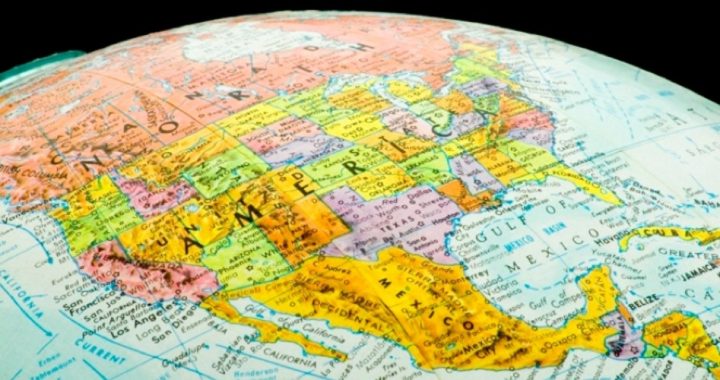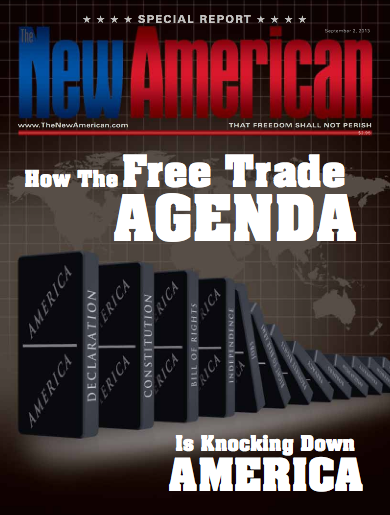
On January 2, 1988, leaders of the United States and Canada met to sign the first major agreement in decades designed to comprehensively lower trade barriers between the two countries. Since the 1850s, American and Canadian politicians had striven to lower or eliminate trade barriers between the two countries, with uneven success; the first such agreement, the Elgin-Marcy Treaty of 1854, was torpedoed by the United States only 12 years later in retaliation for British support of the Confederacy during the Civil War, and successive efforts over the years at eliminating various protectionist policies inevitably fell prey to cries of protectionism or favoritism on one side or the other.
But 1988’s Free Trade Agreement (FTA) would be different, leaders in both countries assured their respective citizenries. This time around, trade barriers would be lowered across the board, and protective tariffs and other barriers become a thing of the past. Moreover, Americans and Canadians received glib assurances that the agreement would in nowise jeopardize the sovereignty or independence of either country.
In one respect, American and Canadian leaders were telling their constituents the truth: This trade agreement was different. The FTA — unlike its various abortive predecessors over the previous 130 years — was intended to be but the first step in a process of economic and political integration that would indeed, over the long run, abolish the independence not only of the United States and Canada, but the rest of North America as well.
Despite its significance, the FTA was passed with little fanfare in the United States, where President Reagan presented it to Congress under a “fast-track” procedure that limited debate and disallowed amendments.
As it stood, the FTA was a fairly typical trade accord, but it did not come about in a vacuum. Unnoticed by most lawmakers at the time of its passage was another initiative, under way since 1986, to create a trilateral trade agreement involving not only Canada and the United States, but also Mexico. This agreement, which was to become the North American Free Trade Agreement (NAFTA) only a few years later, was the real prize; the FTA was supposed to lay the groundwork for, and be superseded by, NAFTA, and was only negotiated because those favoring a more comprehensive trade agreement knew that a Canada-U.S. accord would be much easier to achieve.
NAFTA, which came into force in 1994, was billed as a sort of expanded FTA, but in reality, it was nothing of the sort. Rather, NAFTA was North America’s first foray into transnational government camouflaged as a “free trade agreement,” of the sort that the Europeans had been building on the other side of the Atlantic since the 1950s.
By the 1990s, it was very clear to any careful observer what was afoot in Europe. All rhetoric aside, what had begun in 1951 as an international commission regulating the trade of coal and steel, and had soon morphed into the European Economic Community (informally termed the “Common Market”), was well on its way to becoming a bona fide continent-wide government. The Maastricht Treaty of 1992, which created both the European Union and a continent-wide currency, the euro, established once and for all the real agenda of Europe’s “free trade” movement: the creation of a superstate to govern the formerly independent nations of Europe.
Continent-wide Government
With the creation of the North American Free Trade Agreement, the process of creating continent-wide government began anew, but this time on the other side of the Atlantic. Having had so much success in building a regional government in Europe using free trade as a pretext, the globalists, who have always had international — and eventually global — government as their overarching goal, decided to recycle the formula in the New World.
NAFTA was sold to Congress and the American public as a “free trade agreement.” But instead of creating conditions for free trade (borders transparent to the flow of goods, services, and people), NAFTA set up a complex bureaucracy tasked with managing and controlling North American trade and with adjudicating trade disputes. In other words, NAFTA was not a “free trade” but rather a “managed trade” agreement, in complete conformity with the creed of socialists of every hue that the free market cannot be trusted, and that all mercantile activity must be closely monitored and managed by allegedly benevolent bureaucrats who can determine, better than market forces, how much of a given good to produce, at what price, and up to what standards.
Moreover, NAFTA, by imposing such a managed trade regime across international boundaries, was not merely an “accord” but also a first layer of regional international government where none had existed before. Of course, treaties have always involved concessions of absolute sovereignty in order to be binding; what makes NAFTA different from traditional international treaties (and similar to the United Nations, the European Union, and the World Trade Organization) is that it created international review panels (such as those contemplated by NAFTA’s Chapter 19) for enforcement of its provisions — organs whose decisions are understood to supersede any legislation or ruling by local, state, or even federal legislatures or courts. And NAFTA’s over 900 pages of verbiage are a compendium of new rules and regulations to which all laws and regulations — local, state, and national — in all three participating countries are required to conform.
And more is on the way — much more. No sooner was the ink dry on the NAFTA agreement, than North American foreign policy elites such as Robert Pastor, professor of International Relations at American University and longtime foreign affairs insider, began advocating a more integrated North America than NAFTA can furnish. In 2001, in Toward a North American Community: Lessons From the Old World for the New, the first in a series of books promoting greater North American integration, Pastor lamented the inadequacies of the then-six year old NAFTA agreement:
What’s wrong with NAFTA is not what it did, but what it omitted. The agreement did not envisage any unified approach to extract NAFTA’s promise, nor did it contemplate any common response to new threats…. In the absence of a compelling vision to define a modern regional entity, and lacking institutions to translate that vision into policies, the old patterns of behavior among the three governments remained.
In a 2004 article for Foreign Affairs entitled “North America’s Second Decade,” Pastor (a member of the Council on Foreign Relations, CFR) admitted that NAFTA is “merely the first draft of an economic constitution for North America,” while decrying the monumental setback to continental integration entailed by the 9/11 attacks. Following 9/11, the United States virtually sealed its borders and returned to its traditional unilateralism, Pastor lamented, whereas in a more enlightened future, “security fears would serve as a catalyst for deeper integration.” Acknowledging the obstacle of Mexico’s underdevelopment relative to her two northern neighbors, Pastor advocated the establishment of a “North American Investment Fund” to funnel hundreds of billions of taxpayer dollars from Canada and the United States to Mexico. Stiff cultural resistance in all three countries to submersion in a North American Community would be overcome by the establishment of “Centers for North American Studies” to “help people in all three countries to understand the problems and the potential of an integrated North America — and to think of themselves as North Americans.”
From such policy recommendations as these emerged, in 2005, “Building a North American Community,” a policy statement promulgated by the Council on Foreign Relations, in consultation with the Canadian Council of Chief Executives and the Consejo Mexicano de Asuntos Internacionales (Mexican Council of International Affairs). The statement — of which Pastor was one of the authors — laid out a program for establishing a sort of EU-Lite to take the place of NAFTA. Among its recommendations: a common security perimeter around the borders of North America, harmonization of visa requirements, sharing of data on the exit and entry of foreign nationals, enhanced law-enforcement cooperation, the adoption of a common external tariff, the development of a North American Border Pass with biometric identifiers, and the aforementioned North American Investment Fund and Centers for North American Studies.
Aware of potential red flags among their readership, the document’s authors were careful to distance themselves from the European Union; the “new North American community,” they wrote, “will not be modeled on the European Union or the European Commission, nor will it aim at the creation of any sort of vast supranational bureaucracy.”
Denials and Duplicity
Pastor was quick to point out to detractors, as he wrote in a letter to WorldNetDaily in 2007, that what he is proposing is a “North American Community,” not a “North American Union.” In strict semantic terms, he’s right, but his terminology is deliberately misleading. After all, what began as the European Community (EC) eventually became the European Union. As Pastor admitted in 2001, the European path toward integration ought to be a model for North America; a continent-wide “community” would then inevitably become — as it was in Europe — a precursor to union under full-blown regional government.
As it is, the yet-to-be realized North American Community would extend its competency far beyond trade — as intended. It would require harmonization of policing, immigration laws, and — more ominously — the creation of biometric ID cards. Meanwhile, propaganda organs disguised as centers for North American research would prepare public opinion for further integration down the road, which would doubtless include a single currency and central bank and, ultimately — as has been done in Europe — a continental legislature.
Now, with the perceived threat of economic immolation receding, talk of a continent-wide community has resumed. The indefatigable Pastor published another book, The North American Idea: A Vision of a Continental Future, in 2011, which reiterated the proposals of the previous decade, but dressed up to appeal to post-Great Recession sensibilities. And no part of the Council on Foreign Relations’ 2005 program has been retracted; only last March, Pastor penned a policy initiative for the CFR (Policy Innovation Memorandum no. 29) entitled “Shortcut to U.S. Economic Competitiveness: A Seamless North American Market,” in which he calls for, among other things, negotiating a common external tariff; building public support for a “shared vision” via various information initiatives, such as a “Buy North America” push to replace “Buy America”-type slogans in the United States; forging a “continental plan for transportation and infrastructure” (NAFTA Superhighway, anyone?); and creating a “single North American regulatory group on regulatory issues with a comprehensive strategy.” This last is particularly vague and open-ended; does Pastor truly propose to give an international group competency to overhaul the vast web of American commercial regulations (like the UCC) to bring it into compliance with a regional trade accord? Well, yes. In Pastor’s words:
A merged working group should aim for across-the-board regulatory convergence. This means that pharmaceuticals should be subject to uniform high standards and would not need to be retested in each country, that food imports should be tested just once by North American inspectors, and that regulations on the size, weight, and fuel efficiency of trucks should be the same in all three countries.
Parts of the Plan
But what about more highly publicized, sensational-sounding steps toward North American integration? It is sometimes suggested that plans are afoot for a single North American currency, patterned after the euro, to be styled the “amero.” In point of fact, the “amero” was first proposed by Herbert Grubel, a Canadian economist, in 1999. Robert Pastor endorsed the idea in Toward a North American Community, opining that an amero would be a benefit to all three countries “in the long run.” As long as the U.S. dollar remains the world’s reserve currency, prospects for a North American currency seem remote, but an amero might become an appealing prospect in the event of a dollar crisis.
The “NAFTA Superhighway” has received a good deal of attention in Washington and, if Pastor’s proposal for a “continental plan for transportation and infrastructure” is any indication, the North American globalist crowd is contemplating ways to make roads and other infrastructure amenable to continental integration. But Texas Governor Rick Perry’s “Trans-Texas Corridor” — the original source of concern — has been officially shelved due to public backlash, although it continues surreptitiously under other project names.
As for the North American Union itself, the organization was mentioned by name by former Mexican president Vicente Fox, who wrote, in an online forum discussing his book Revolution of Hope, “Why can’t we be not only partners in the long term, but a North American Union?” In 2001, Fox told a PBS documentary on world trade that he expected “convergence of our two economies [i.e., those of the United States and Mexico], convergence on the basic and fundamental variables of the economy, convergence on rates of interest, convergence on income of people, convergence on salaries.” He hoped that a future generation of North American leaders would “erase that border, open up that border for [the] free flow of products, merchandises, [and] capital as well as people.”
Beyond these candid statements of President Fox, few if any would-be supporters of a North American Union have gone on record promoting such an organization by name. A few, such as Pastor, have been careful to draw semantic distinctions between “union” and “community,” but, as the Europeans can attest, weasel words mean far less than intent. And of that there can be no mistake: North America’s elites covet regional government no less than do their European counterparts. After all, elites on both sides of the Atlantic ardently support that embryonic global government, the United Nations.
As a general principle, those who believe government is the best solution to every problem (and most political leaders and policy analysts do) always want more and more government — including, wherever possible, regional and global government. The same fetish for regulatory control exhibited by so-called “liberals” in the domestic arena is no less ardent in the international sphere.
The European Union was brought about on a continent that had seen two world wars in less than a half century, and was partitioned by the Cold War for another four and a half decades. North America has seen no comparable international conflict since the first half of the 19th century. Trade among the United States, Canada, and Mexico is brisk. The threat of external terrorism provides some pretext, but nothing on the scale that Nazism or World War II did for Europe. In short, nothing less than an epochal socioeconomic meltdown is likely to furnish the political camouflage for dissolving the borders between the United States and her northern and southern neighbors. In the meantime, expect the Robert Pastors of the world to continue laying the groundwork for eventual North American economic and political union, while simultaneously pushing Transatlantic and Trans-Pacific mergers via the Transatlantic Trade and Investment Partnership (TTIP) and Trans-Pacific Partnership (TPP).
 The above article is part of our special report “How the Free Trade Agenda Is Knocking Down America.” This report warns that the free trade agenda is a dangerous and deceptive bait and switch. The intent is not to create genuine free trade but to transfer economic and political power to regional arrangements on the road to global governance. Because of what is at stake, we encourage you to read the entire special report (click here for the PDF) and to become involved.
The above article is part of our special report “How the Free Trade Agenda Is Knocking Down America.” This report warns that the free trade agenda is a dangerous and deceptive bait and switch. The intent is not to create genuine free trade but to transfer economic and political power to regional arrangements on the road to global governance. Because of what is at stake, we encourage you to read the entire special report (click here for the PDF) and to become involved.



